VitroGel® vs. Animal-Based ECMs
A comprehensive comparison on key features, operation, application, and storage conditions.
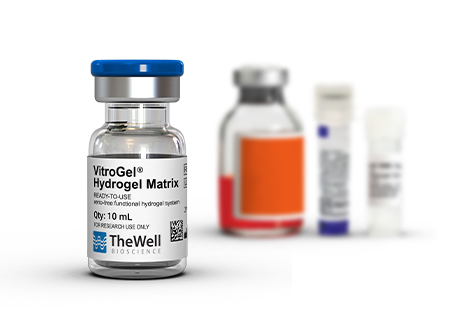
Start with the end in mind.
VitroGel® offers a defined synthetic hydrogel system that closely mimics the natural ECM environment without animal or human components. This system gives researchers control over mechanical strength, functional ligands, and degradability, allowing for the creation of precise biomimetic environments tailored for various applications in drug discovery, tissue engineering, and cell therapy.
In contrast, animal-based ECMs suffer from batch-to-batch inconsistency and contain over 2,000 undefined components, highlighting the superior consistency and defined nature of the VitroGel® system for advanced biomedical research and development.
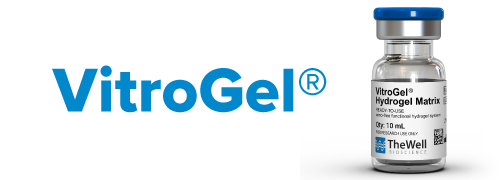
VS

KEY FEATURES
VitroGel® is synthetic, maintains liquid form at room temperature, and closely mimics the natural ECM environment without any animal or human components.
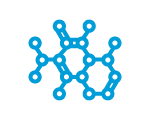
Pure synthetic hydrogel with bio-functional modification; no growth factors or proteins in the gel solution.
Composition

ECM protein derived from mouse tumor; ~2000 undefined compounds, including various growth factors.

Room temperature stable with room temperature protocol. Gelation is triggered by mixing with cell medium (ionic crosslink). Learn how gelation works >
Temperature Stability/Gelation
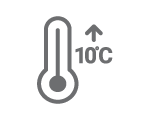
Temperature sensitive. Operation protocol at 4°C. Requires ice bucket. Temperature fluctuation triggers gelation.

Tunable. With the high-concentration hydrogels, adjust the mechnical strength from 10 Pa to over 20,000 Pa. Can also be customized with higher strength.
Gel Strength

Non-tunable, soft hydrogel.

Long-term injectability after gelation without needle clogging.
Injectability

Short-term injectability as a liquid;
Non-injectable after gelation.

No toxicity, no inflammatory response, safe for in vivo application.
Biocompatibility

Tumor-derived origin, difficult to distinguish biological effects.

Consistency in batch-to-batch.
Available for GMP process.
GMP
(Batch-to-batch Consistency)

Inconsistency in batch-to-batch.
No regulatory approval.
OPERATION
VitroGel® is ready-to-use at room temperature, supports most cell types, works with any imaging analysis, allows easy cell recovery, and enables downstream applications.
VitroGel®

Liquid form at room temperature, directly mix with cell medium, less than 20 min.
Easy Protocol
Animal-Based ECM

Pre-thaw from -20°C, use at ice temperature, 37°C incubation for gelation, more than 2 hr.

Fully adjustable. Defined supplement can be added with cell medium for consistent results.
Supplement

Due to the unknown compositions of animal ECM, supplements may or may not be needed.

Feasible for any cell treatment before or after gel-cell mixing, excellent cell/molecular penetration.
Cell Treatment

Unknown interaction between matrix compounds with treating compounds, hard for cell penetration.

Transparent, compatible with many imaging system and downstream analysis. Samples can be stained directly with hydrogel.
Imaging

Undefined components cause noise, interference, autofluorescence, and misleading data. Cell harvesting is needed before staining.

Easy cell harvesting using enzyme-free recovery solution, <20 minutes, at 37°C.
Cell Harvesting

Requires strong recovery solution at ice temperature for 2 hr.

Excellent for RNA/DNA/Protein extraction. No cell harvesting needed. High yield, high purity, and low background noise for downstream analysis.
Extraction & Downstream

Not ideal for RNA/DNA/Protein Extraction. Requires cell harvesting before any extraction. Has strong background noise which makes further analysis extremely difficult.
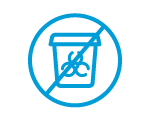
VitroGel® is stable at room temperature and easy to handle, with no stickiness resulting in zero (0%) material waste during operation.
Material Waste
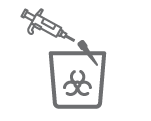
Due to animal-based ECM’s sticky consistency and temperature sensitivity, ~20–30% of operational material is wasted during operation.
APPLICATIONS
VitroGel® is versatile, covering many animal-based ECM applications with the ability to translate the cell culture assays towards advanced biomedicine.
VitroGel®
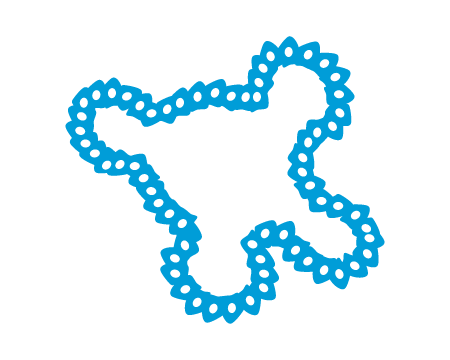
Supports comprehensive organoid/3D models with robust results, downstream analysis and advanced biomedicine.
Organoid/
3D Models
Animal-Based ECM

Batch-to-batch difference in culture results, difficult for downstream analysis such as protein assay. Does not allow clinical use.

Excellent for live or cryo tissue culture, long-term preservation of tissue phenotypes for drug testing & diagnostic uses.
Ex Vivo/ Tissue preservation

Unknown compounds may change the phenotype of tissue samples, causing misleading data during analysis.

Supports great immune cell penetration for immuno-oncology, co-culture with easy image observation.
Immuno
co-culture

Blocks some cell penetration or movement within the matrix. Unknown interactions from matrix compounds may affect the results.

Innovative 3D culture method to support stem cell scale-up and differentiation for cell therapy applications.
Stem Cell
Scale-Up
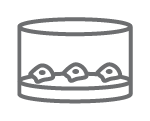
Traditional 2D matrix coating method for stem cell culture is limited by the surface of the culture vessels and is risky for biomedical applications.

Supports the typical and advanced invasion/migration assays and enables the in-depth study of cell mobility by adjusting the hydrogel properties.
Invasion

Hard to understand the detailed effects of matrix on cell mobility due to the non-tunable material properties.

Extremely easy to inject, homogenous cell suspension, high retention, fast cell growth, and sample can be prepared for large batch injections.
Xenograft

Difficult to inject, has cell precipitation, and sample preparation are often in small batches.

Temperature stable, lab automation-friendly, easy to adapt with current liquid handling system without additional modification.
HTS
Automation

Temperature unstable, hard to adapt with liquid handling system at room temperature, inconsistent results and requires additional instrument modification.
SHIPPING, STORAGE, STOCK, & Sustainability
VitroGel® is environment-friendly, ethical, and sustainable.
VitroGel®

Ships at ambient temperature. No dry ice required means savings in shipping costs and is more environment-friendly.
Shipping
Animal-Based ECM

Dry ice express shipping required. Increases shipping costs and leaves higher carbon footprint and environmental impact.

Stores at 2-8°C. No aliquotation needed and is ready-to-use. Shelf life of 24 months.
Storage

Stores at -20°C, need aliquotation, and must be thawed before use.

Always in stock.
Maximum of 2-3 weeks lead time if not in stock.
Stock

Risk of backorder for up to 6 months.

VitroGel® hydrogels are pure synthetic systems. No mouse killed during production thus a more ethical and sustainable solution.
Ethical &
Sustainability

ECM protein derived from mouse tumor. For every one (1) vial produced, seven (7) mice are sacraficed.


